Introduction to Rocks
Ready to dig deep into the fascinating world of rocks and minerals? With a science project on rocks and minerals, you can explore everything from the depths of underground caves to the far reaches of outer space. Start by learning the basics about rocks and minerals, then dive into an exciting range of projects that may involve examining rock samples, testing their physical characteristics, and discovering their origins. Get started on your adventure today!
What is a rock?
 A rock is made from different minerals stuck together by nature. The minerals in a rock might have been formed in the rock at different times, so a rock can be constantly changing. Some common rocks are limestone, sandstone, and granite.
A rock is made from different minerals stuck together by nature. The minerals in a rock might have been formed in the rock at different times, so a rock can be constantly changing. Some common rocks are limestone, sandstone, and granite.
What is a mineral?
 Minerals are natural substances that are made up of one type of compound that's arranged in an orderly way. Each mineral looks different and has its own special properties that set it apart from others. Some examples of minerals are quartz, feldspar, mica, and calcite.
Minerals are natural substances that are made up of one type of compound that's arranged in an orderly way. Each mineral looks different and has its own special properties that set it apart from others. Some examples of minerals are quartz, feldspar, mica, and calcite.
What is a crystal?
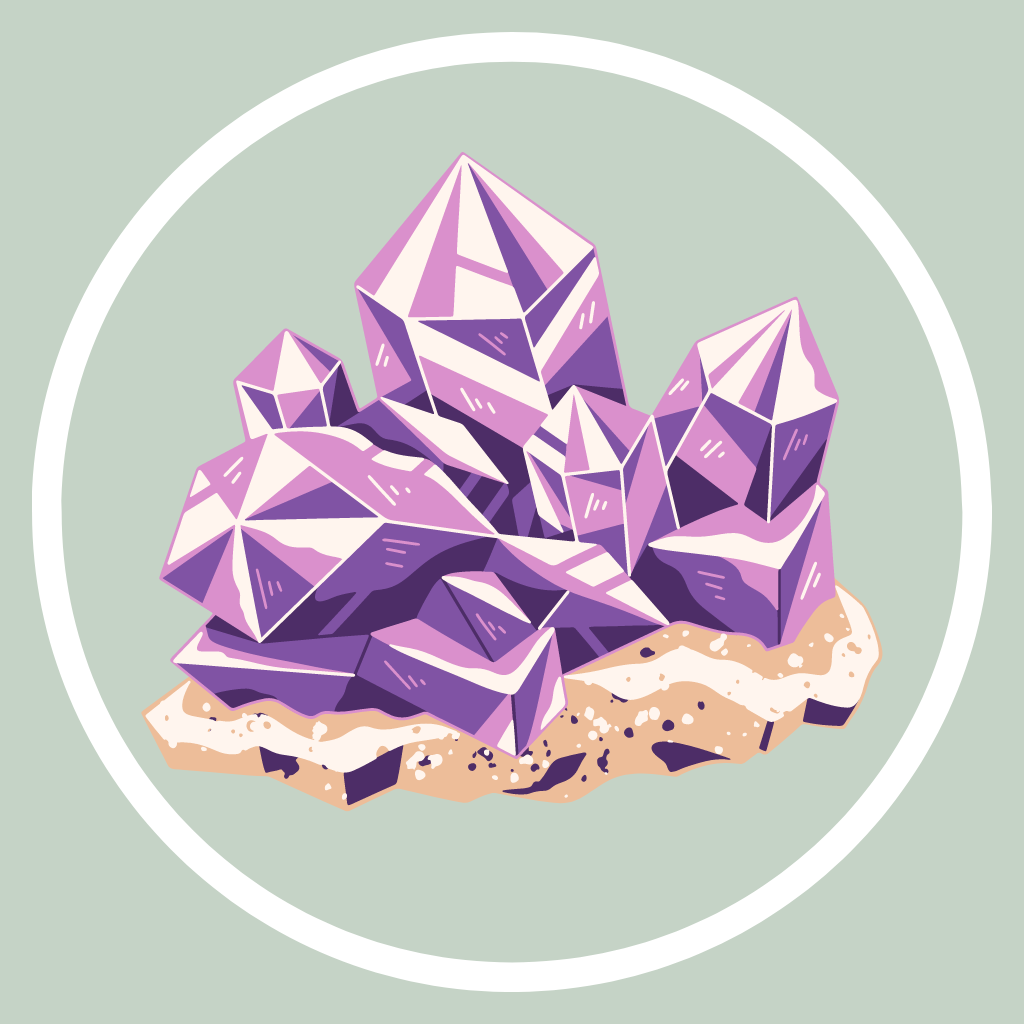 A crystal is a mineral with an orderly pattern of atoms, which is reflected in the geometric shape of the crystal as it grows larger. Differences in temperature and chemical composition cause variations, but crystals need ideal growing conditions and room to grow to show their geometric form. Most rocks are made up of many tiny mineral crystals, but large museum-quality crystals have room to grow uninhibited. Some common crystals are diamonds (carbon crystals), quartz (silicon dioxide crystals), pyrite (fool's gold, iron sulfide crystals) and salt (sodium chloride crystals).
A crystal is a mineral with an orderly pattern of atoms, which is reflected in the geometric shape of the crystal as it grows larger. Differences in temperature and chemical composition cause variations, but crystals need ideal growing conditions and room to grow to show their geometric form. Most rocks are made up of many tiny mineral crystals, but large museum-quality crystals have room to grow uninhibited. Some common crystals are diamonds (carbon crystals), quartz (silicon dioxide crystals), pyrite (fool's gold, iron sulfide crystals) and salt (sodium chloride crystals).
What are the 3 types of rocks?
Sedimentary rocks
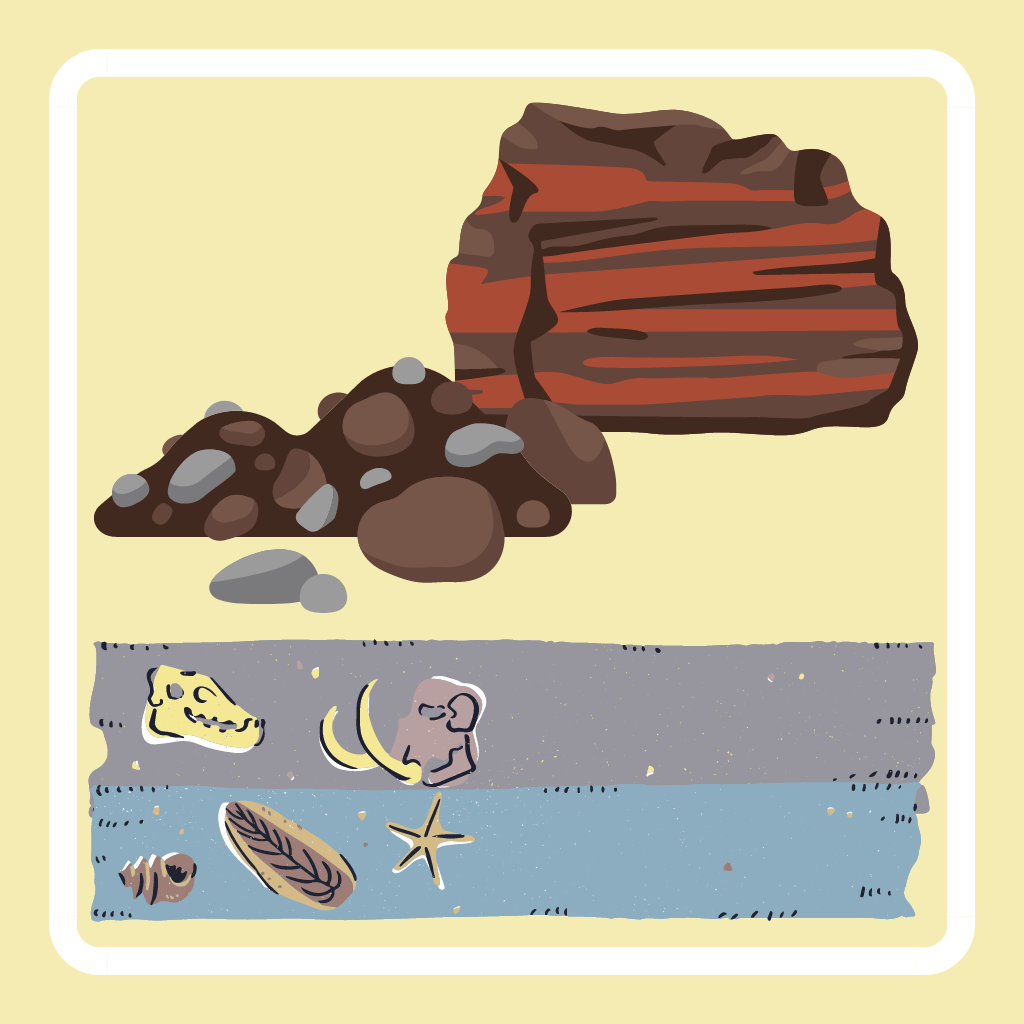 Sedimentary rocks are made from pieces of rocks or once-living things that pile up on the Earth's surface. Because of this, sedimentary rocks usually have layers, and some famous formations in the desert are made of sedimentary rocks.
Sedimentary rocks are made from pieces of rocks or once-living things that pile up on the Earth's surface. Because of this, sedimentary rocks usually have layers, and some famous formations in the desert are made of sedimentary rocks.
There are three different types of sedimentary rocks:
Clastic sedimentary rocks are formed from pieces of rocks that are cemented together. Some clastic sedimentary rock examples are sandstone, shale, siltstone and breccia.
Chemical sedimentary rocks are formed when dissolved substances precipitate out of the solution and become a solid. Some chemical sedimentary rock examples are rock salt, limestone, iron ore, flint, chert and some dolomites.
Biologic sedimentary rocks are formed when many living things die, and these rocks are often where fossils are found. Some examples of biologic sedimentary rock examples are coal, chalk, limestone, diatomite and some dolomites.
Metamorphic rocks
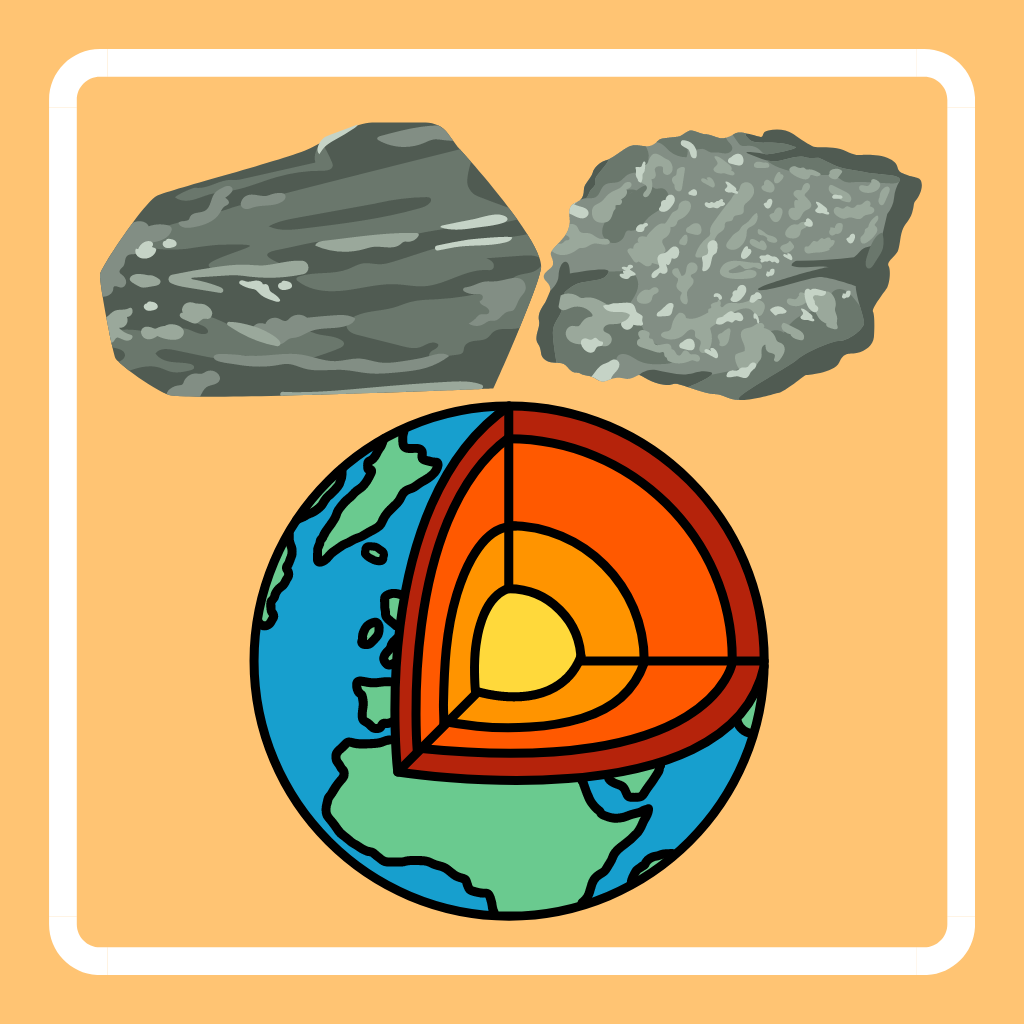 Metamorphic rocks are rocks that have been changed from their original form due to high heat, high pressure, and hot fluids. These conditions are found deep within the Earth or where tectonic plates meet. Metamorphism does not melt the rocks, but transforms them into denser, more compact rocks with new minerals.
Metamorphic rocks are rocks that have been changed from their original form due to high heat, high pressure, and hot fluids. These conditions are found deep within the Earth or where tectonic plates meet. Metamorphism does not melt the rocks, but transforms them into denser, more compact rocks with new minerals.
Some common metamorphic rocks include:
marble - changed from limestone
quartzite - changed from sandstone
slate, phyllite, schist and gneiss - changed from mudrock
granite gneiss - changed from granite
chlorite schist and amphibolite - changed from basalt
Igneous rocks
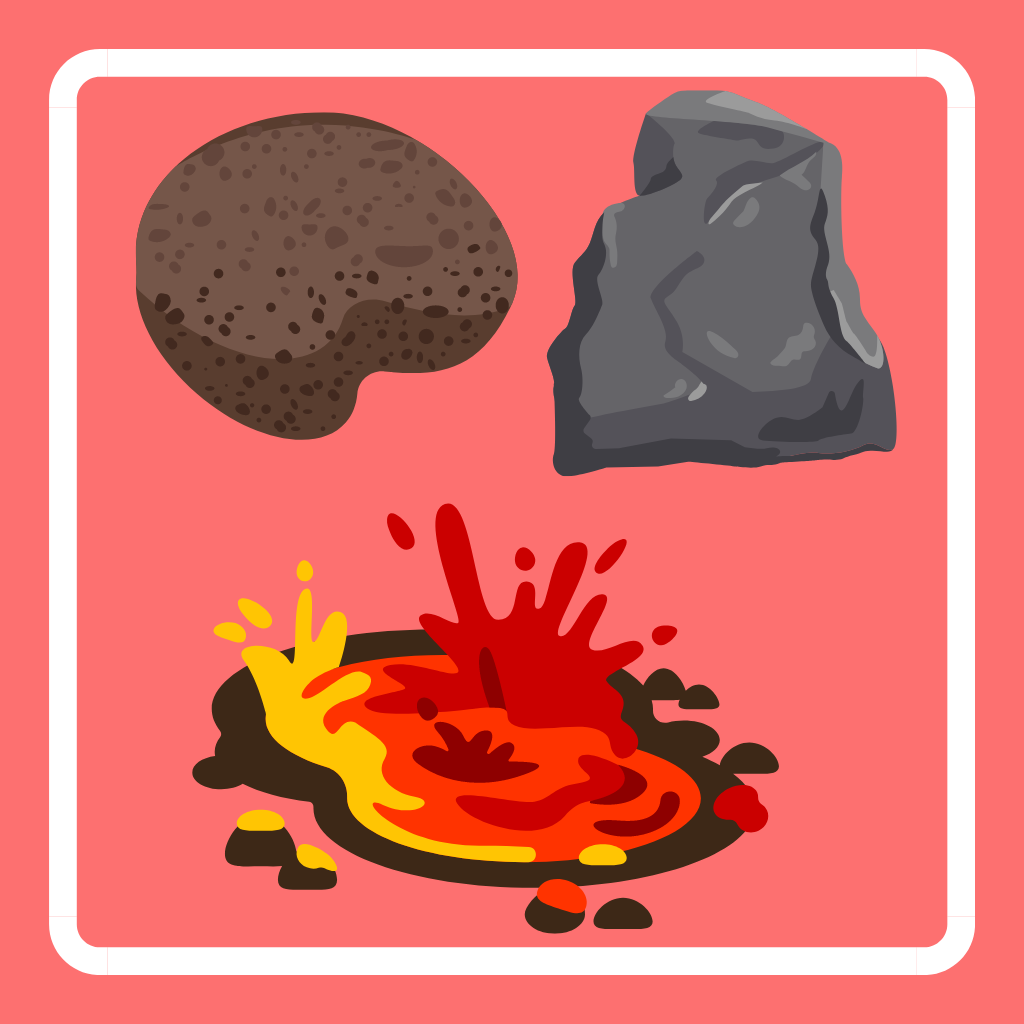 Igneous rocks form when hot, melted rock (magma) cools and hardens. There are two different types, intrusive and extrusive.
Igneous rocks form when hot, melted rock (magma) cools and hardens. There are two different types, intrusive and extrusive.
Intrusive igneous rock
Intrusive rocks cool slowly below the Earth's surface and have large mineral grains. Since intrusive rocks are made inside the earth, they are also called plutonic rocks, named after Pluto, the Greek god of the underworld. Some common intrusive igneous rocks are granite, peridotite, pegmatite, diabase, diorite and gabbro.
Extrusive igneous rock
Extrusive rocks cool quickly on the surface and have small mineral grains or even a glassy texture. Volcanic eruptions produce extrusive rocks, and magma trapped deep in the Earth produces intrusive rocks. Extrusive rocks are also called volcanic rocks because they are formed by volcanic activity, named after Vulcan, the Roman god of fire. Some common extrusive igneous rocks are pumice, basalt, obsidian, rhyolite, dacite, andesite, tuff and scoria.
The Rock Cycle
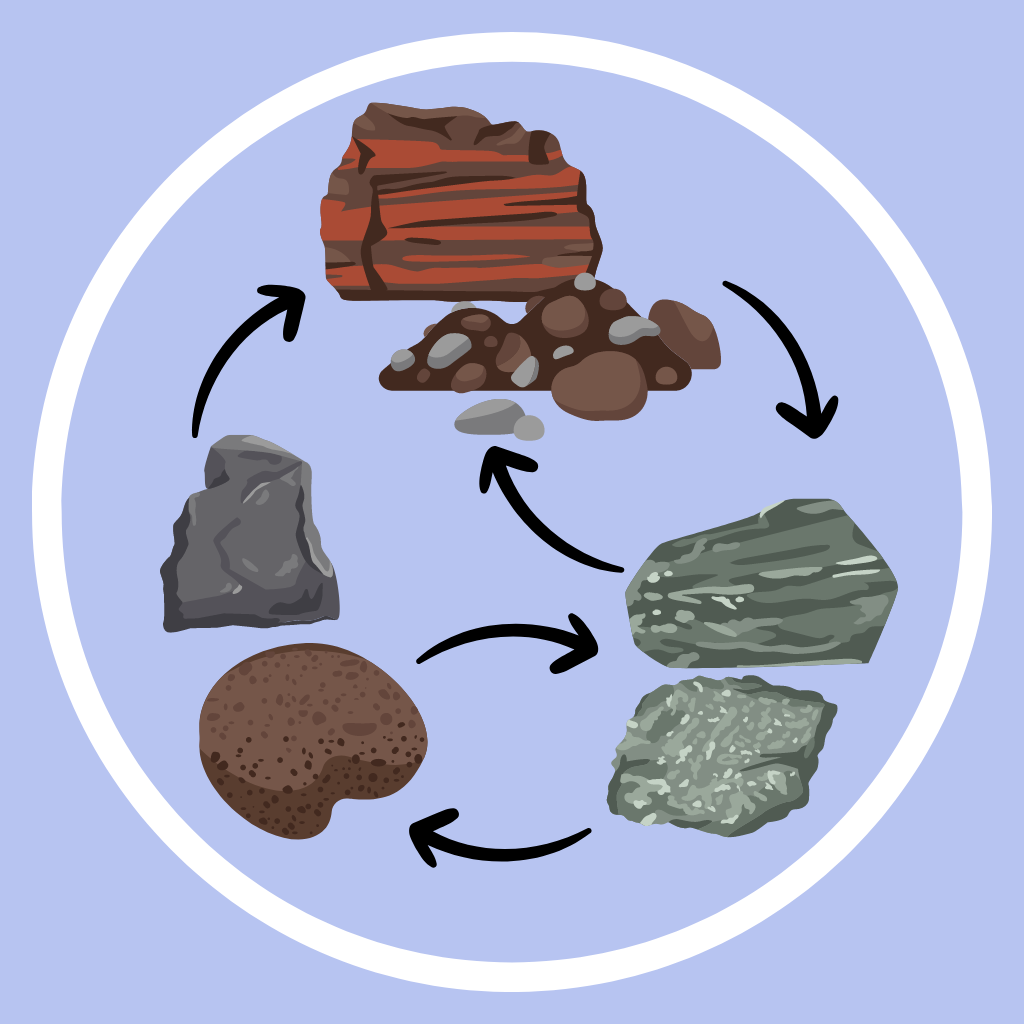 The rock cycle is the process of how rocks can form and change over time. Different types of rocks form in different environments, such as when molten rock cools underground to form an igneous rock or when rocks are exposed to heat and pressure to form metamorphic rocks. When rocks are exposed to weathering and erosion, they can break down into smaller pieces and become part of sedimentary rocks. The rock cycle is an important process that shapes the Earth's surface over millions of years and can take many paths depending on the environment's conditions.
The rock cycle is the process of how rocks can form and change over time. Different types of rocks form in different environments, such as when molten rock cools underground to form an igneous rock or when rocks are exposed to heat and pressure to form metamorphic rocks. When rocks are exposed to weathering and erosion, they can break down into smaller pieces and become part of sedimentary rocks. The rock cycle is an important process that shapes the Earth's surface over millions of years and can take many paths depending on the environment's conditions.
Science Projects on Rocks
What kinds of rock projects are there?
We have rock projects where you'll learn about the physical characteristics of different types of rocks and minerals, the fascinating process of how rocks are formed through the rock cycle, and even get to make your own beautiful crystals! And if that's not enough, delve into the past by studying fossils and uncovering the secrets of the amazing animals and plants that once lived on earth. Check out these rock and mineral science fair projects!
rock collection: categorizing rocks (from soil), testing properties of rock samples (hardness, density, porosity), finding tiny space rocks (micrometeorites).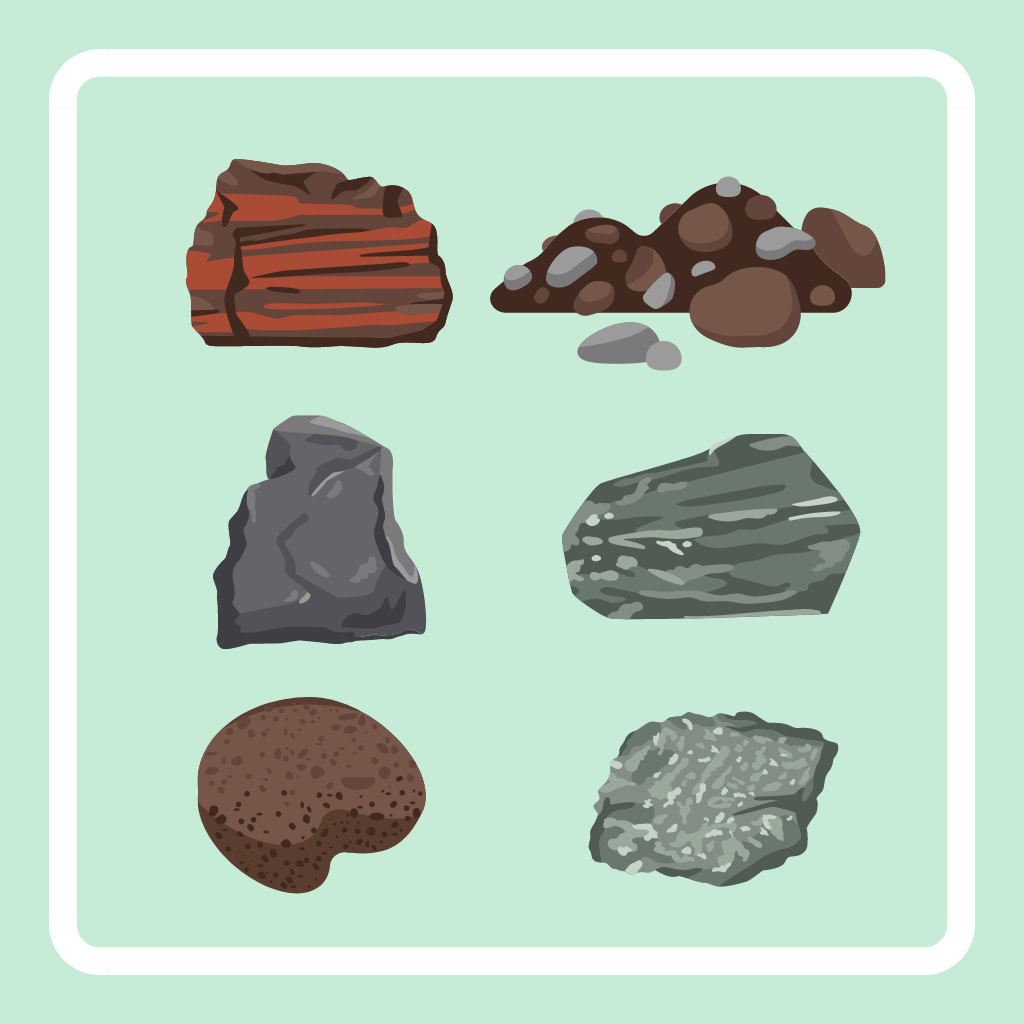
 modeling the rock cycle: sedimentary, metamorphic and igneous rocks, magma (with a Pet Rock, chocolates, Starbursts or crayons)
modeling the rock cycle: sedimentary, metamorphic and igneous rocks, magma (with a Pet Rock, chocolates, Starbursts or crayons)
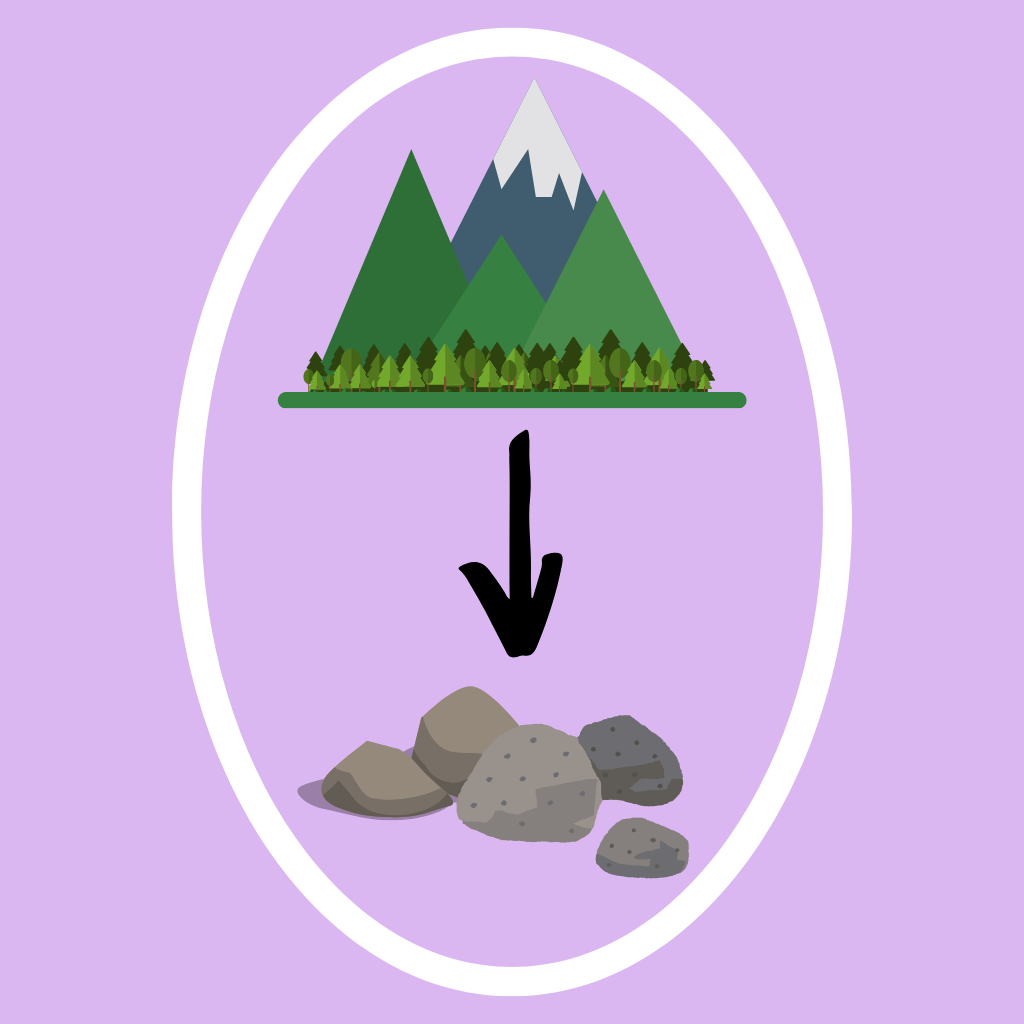 exploring how rocks are made and broken down: weathering & erosion (ice, mountain, soil), eruptions (volcano)
exploring how rocks are made and broken down: weathering & erosion (ice, mountain, soil), eruptions (volcano)
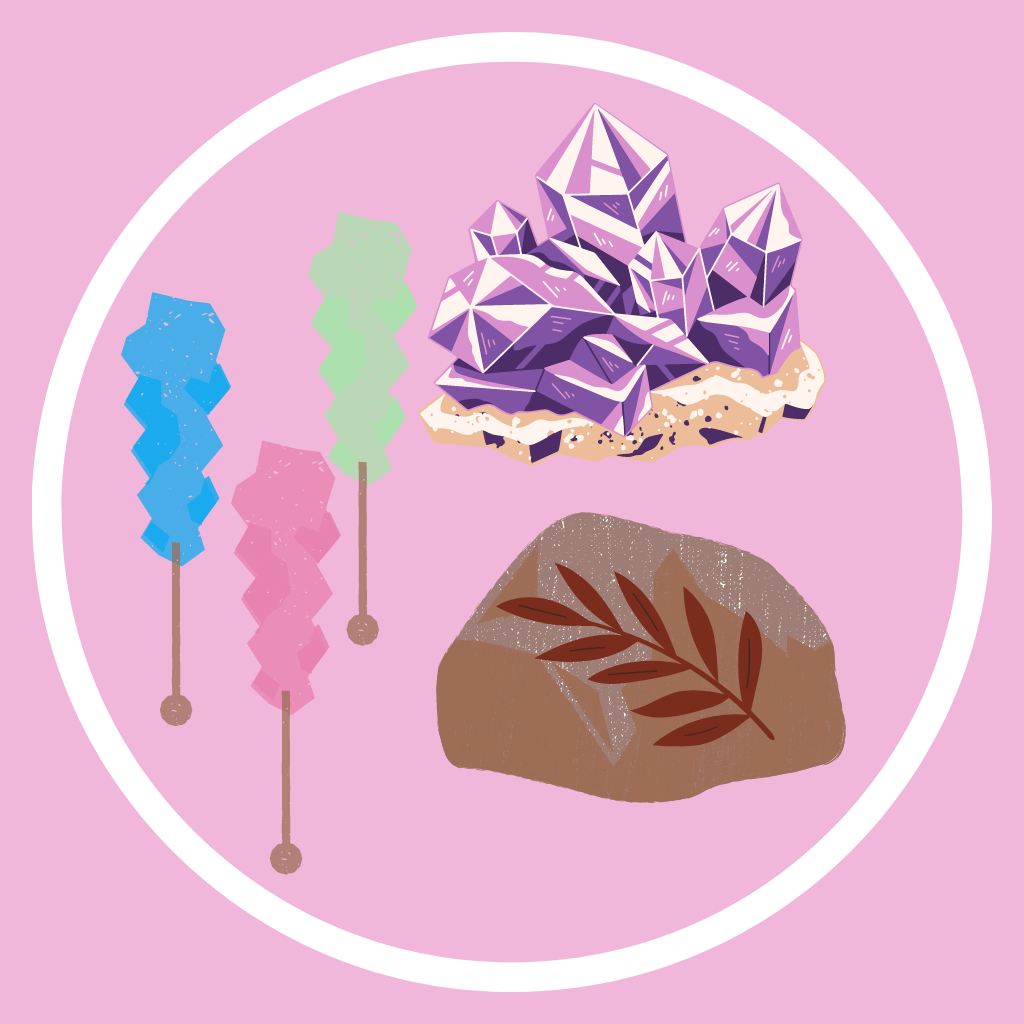 making your own: crystals (sugar, salt, borax), fossils, stalactites and stalagmites
making your own: crystals (sugar, salt, borax), fossils, stalactites and stalagmites
Browse Science Projects on Rocks
Check out these rock projects with complete instructions and videos. They're great for students' science fair projects or a fun way for kids to learn about their rock samples!
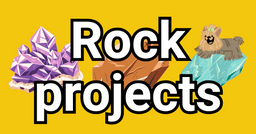

 A rock is made from different minerals stuck together by nature. The minerals in a rock might have been formed in the rock at different times, so a rock can be constantly changing. Some common rocks are limestone, sandstone, and granite.
A rock is made from different minerals stuck together by nature. The minerals in a rock might have been formed in the rock at different times, so a rock can be constantly changing. Some common rocks are limestone, sandstone, and granite. Minerals are natural substances that are made up of one type of compound that's arranged in an orderly way. Each mineral looks different and has its own special properties that set it apart from others. Some examples of minerals are quartz, feldspar, mica, and calcite.
Minerals are natural substances that are made up of one type of compound that's arranged in an orderly way. Each mineral looks different and has its own special properties that set it apart from others. Some examples of minerals are quartz, feldspar, mica, and calcite. A crystal is a mineral with an orderly pattern of atoms, which is reflected in the geometric shape of the crystal as it grows larger. Differences in temperature and chemical composition cause variations, but crystals need ideal growing conditions and room to grow to show their geometric form. Most rocks are made up of many tiny mineral crystals, but large museum-quality crystals have room to grow uninhibited. Some common crystals are diamonds (carbon crystals), quartz (silicon dioxide crystals), pyrite (fool's gold, iron sulfide crystals) and salt (sodium chloride crystals).
A crystal is a mineral with an orderly pattern of atoms, which is reflected in the geometric shape of the crystal as it grows larger. Differences in temperature and chemical composition cause variations, but crystals need ideal growing conditions and room to grow to show their geometric form. Most rocks are made up of many tiny mineral crystals, but large museum-quality crystals have room to grow uninhibited. Some common crystals are diamonds (carbon crystals), quartz (silicon dioxide crystals), pyrite (fool's gold, iron sulfide crystals) and salt (sodium chloride crystals). Sedimentary rocks are made from pieces of rocks or once-living things that pile up on the Earth's surface. Because of this, sedimentary rocks usually have layers, and some famous formations in the desert are made of sedimentary rocks.
Sedimentary rocks are made from pieces of rocks or once-living things that pile up on the Earth's surface. Because of this, sedimentary rocks usually have layers, and some famous formations in the desert are made of sedimentary rocks.  Metamorphic rocks are rocks that have been changed from their original form due to high heat, high pressure, and hot fluids. These conditions are found deep within the Earth or where tectonic plates meet. Metamorphism does not melt the rocks, but transforms them into denser, more compact rocks with new minerals.
Metamorphic rocks are rocks that have been changed from their original form due to high heat, high pressure, and hot fluids. These conditions are found deep within the Earth or where tectonic plates meet. Metamorphism does not melt the rocks, but transforms them into denser, more compact rocks with new minerals. Igneous rocks form when hot, melted rock (magma) cools and hardens. There are two different types, intrusive and extrusive.
Igneous rocks form when hot, melted rock (magma) cools and hardens. There are two different types, intrusive and extrusive. The rock cycle is the process of how rocks can form and change over time. Different types of rocks form in different environments, such as when molten rock cools underground to form an igneous rock or when rocks are exposed to heat and pressure to form metamorphic rocks. When rocks are exposed to weathering and erosion, they can break down into smaller pieces and become part of sedimentary rocks. The rock cycle is an important process that shapes the Earth's surface over millions of years and can take many paths depending on the environment's conditions.
The rock cycle is the process of how rocks can form and change over time. Different types of rocks form in different environments, such as when molten rock cools underground to form an igneous rock or when rocks are exposed to heat and pressure to form metamorphic rocks. When rocks are exposed to weathering and erosion, they can break down into smaller pieces and become part of sedimentary rocks. The rock cycle is an important process that shapes the Earth's surface over millions of years and can take many paths depending on the environment's conditions.
 modeling the rock cycle: sedimentary, metamorphic and igneous rocks, magma (with a
modeling the rock cycle: sedimentary, metamorphic and igneous rocks, magma (with a  exploring how rocks are made and broken down: weathering & erosion (
exploring how rocks are made and broken down: weathering & erosion ( making your own: crystals (
making your own: crystals (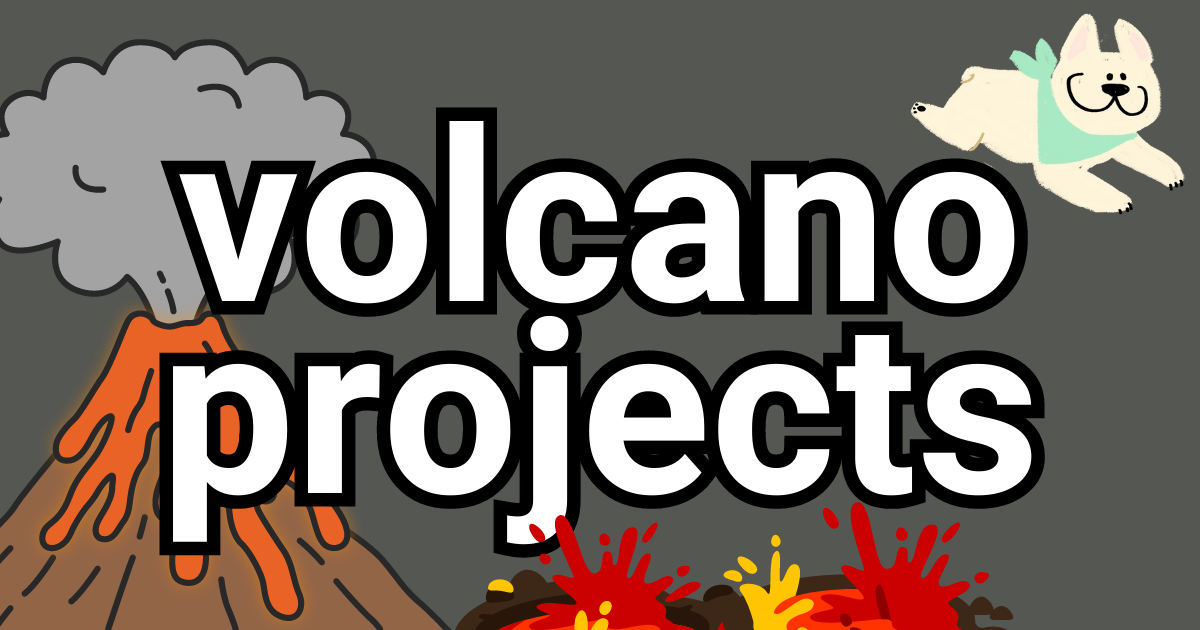 Build your own volcano model or make a lava lamp, all using science! Explore the depths of volcanos with these science projects! Browse
Build your own volcano model or make a lava lamp, all using science! Explore the depths of volcanos with these science projects! Browse 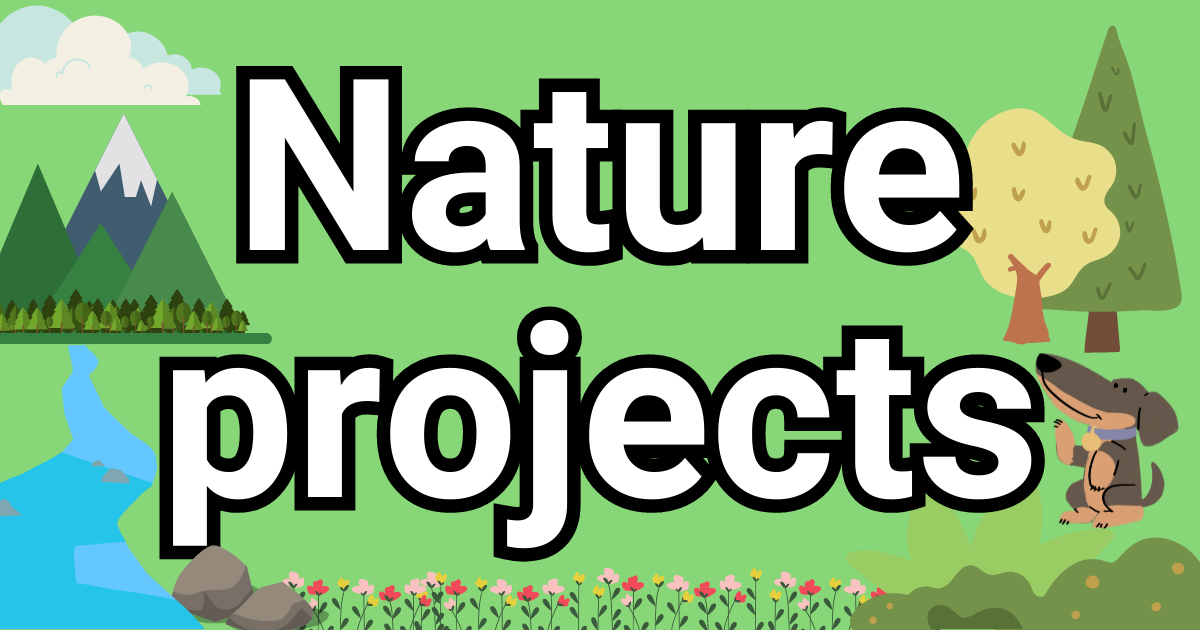 Nature is full of amazing things to explore! Let's go outside and have some fun with these nature science projects! Browse
Nature is full of amazing things to explore! Let's go outside and have some fun with these nature science projects! Browse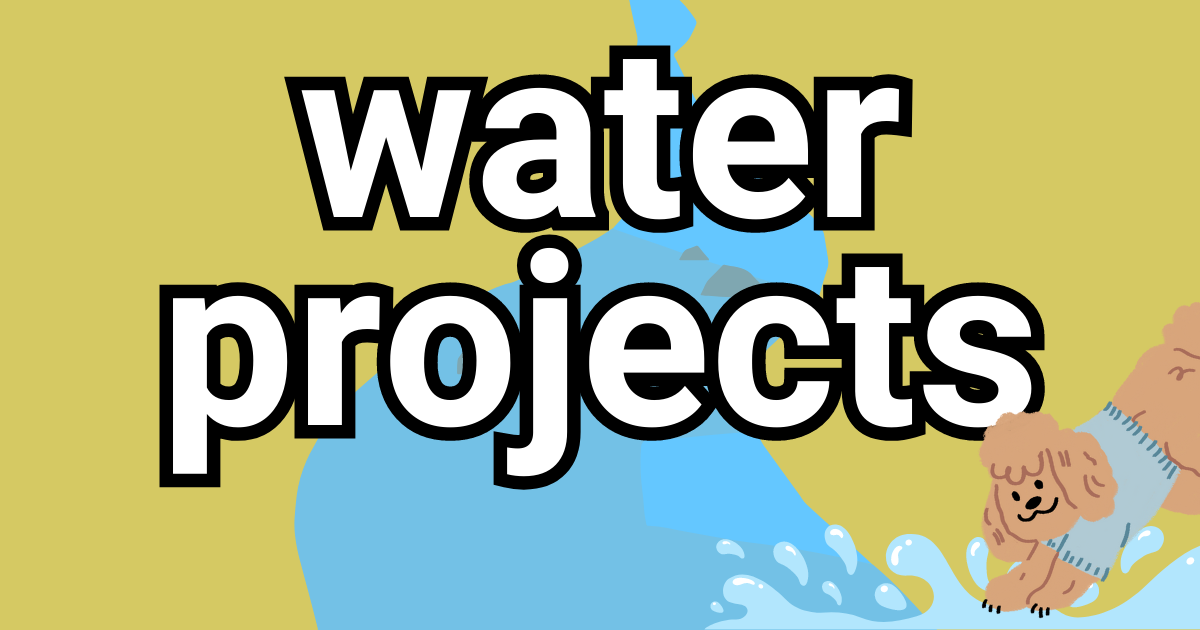 Explore how water plays a vital role in plants, discover the special properties that make water unique and do fun chemical reactions with water! Dive in and discover the fascinating world of water! Browse
Explore how water plays a vital role in plants, discover the special properties that make water unique and do fun chemical reactions with water! Dive in and discover the fascinating world of water! Browse 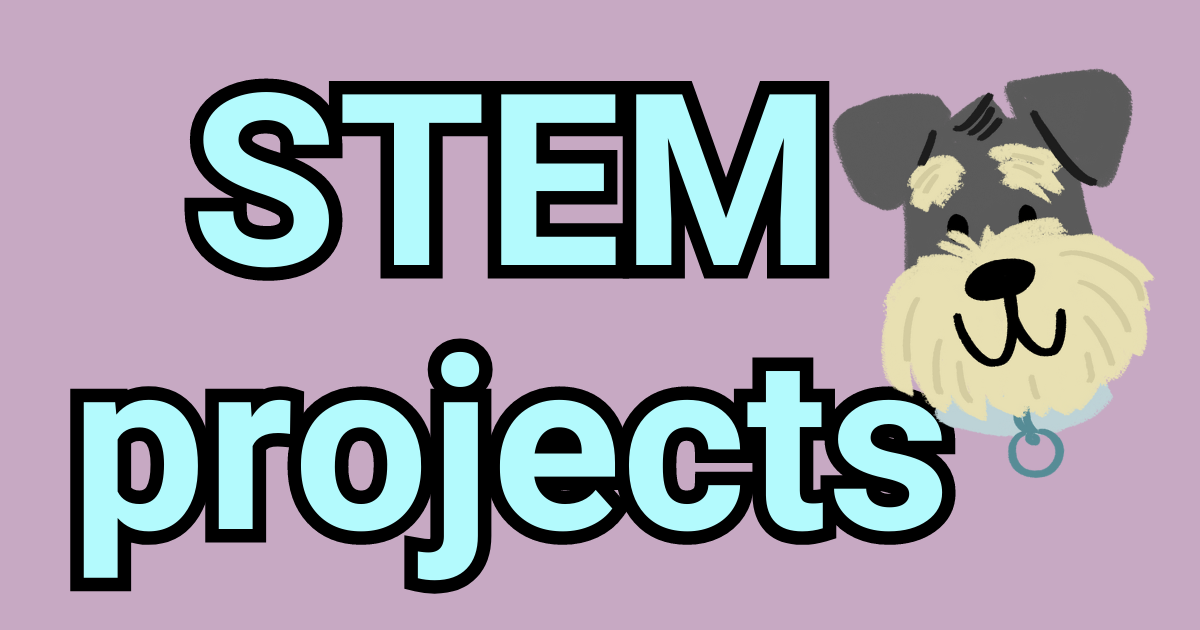 Explore the wonder and excitement of these STEM projects! Each of these only need a few items you may have at home, so it's an easy and fun way to teach kids about STEM! Browse
Explore the wonder and excitement of these STEM projects! Each of these only need a few items you may have at home, so it's an easy and fun way to teach kids about STEM! Browse  Geology is the study of rocks, minerals, and the earth's surface. From volcanoes to fossils to earthquakes, geology helps us understand the forces that shape our planet. Explore
Geology is the study of rocks, minerals, and the earth's surface. From volcanoes to fossils to earthquakes, geology helps us understand the forces that shape our planet. Explore  Chemistry is the study of matter, which is everything around us! Explore different chemical reactions in these science projects! Browse
Chemistry is the study of matter, which is everything around us! Explore different chemical reactions in these science projects! Browse  Physics is the study of how the universe works. Discover the forces and motions that give rise to volcanic eruptions! Browse
Physics is the study of how the universe works. Discover the forces and motions that give rise to volcanic eruptions! Browse  Engineering is all about solving problems using science and math. Browse
Engineering is all about solving problems using science and math. Browse